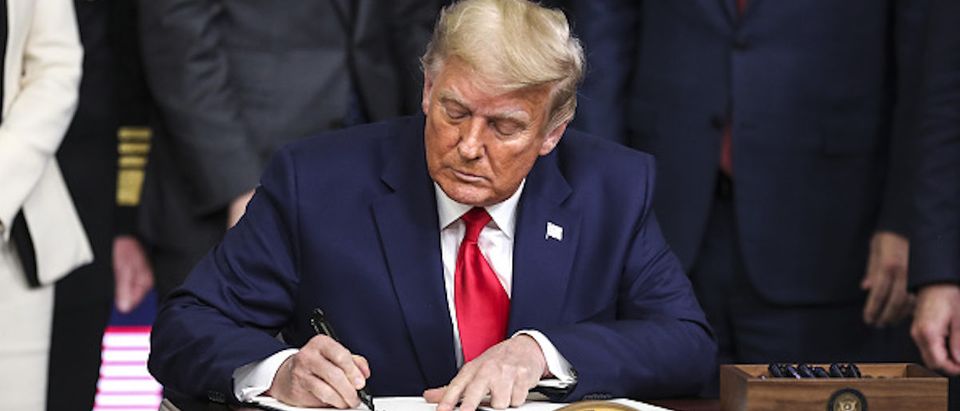The wasteful spending included in the coronavirus relief bill reinforces the need to revisit a long-proposed initiative advocated for by multiple presidents in history – that of the presidential line item veto.
The COVID relief bill didn’t go far enough to provide Americans in need and didn’t provide the $2,000 President Trump had advocated for — instead only offering $600. Aside from that monetary disagreement, President Trump made a larger point in an address to the nation by highlighting all the “pork” in this bill which has nothing to do with putting money directly into the pockets of Americans in financial distress.
Expressing his displeasure, he returned a red-lined version of the bill which recommended removal of extraneous items unrelated to stimulus checks. Yet despite his public remarks and his red-line recommendations, he is powerless to remedy this bill.
President Trump is in good company though in wanting to be able to remove items he deems unnecessary from bills that come across his desk. All the way back to Thomas Jefferson in the early 1800s, presidents have expressed concern over wasteful federal spending and have viewed the presidential line item veto as a way to cut out some of that waste. Although he tried, even Thomas Jefferson was unsuccessful in making the case for this executive branch power.
In his 1986 State of the Union address to Congress, President Ronald Reagan said, “Tonight I ask you to give me what forty-three governors have: Give me a line-item veto this year. Give me the authority to veto waste, and I’ll take the responsibility, I’ll make the cut, I’ll take the heat.”
That power was not ever given to President Reagan during his two terms as president either.
Reagan saw the benefit of this power specifically as a deterrent, as much as a useful tool. He believed that if Congress knew a president had this power available to them, that Congress wouldn’t even bother sending pork-filled bills they knew would be trimmed down immediately. President Jefferson asserted that the Chief Executive should have some discretion over the expenditure of monies appropriated by Congress. Many since then, and still today, wholeheartedly agree.
When Ronald Reagan left office he never looked back with regret, though did feel as if there was some unfinished business. One of the rare issues he spoke out on frequently during his post-presidency years was the need for the line item veto. Forty-three governors at the time (now forty-four) had some form of line item veto power to reduce spending, but until 1996 no such mechanism existed at the federal level.
In that year, Congress did enact the Line Item Veto Act with strong bipartisan support. However, in 1998 the Supreme Court decided it was unconstitutional because it gave the president the power to veto a portion of a bill as opposed to the entire bill, as authorized by Article I, Section 7 of the Constitution.
To show how effective this tool could be in the long term, during its very brief two-year tenure, President Bill Clinton used the line item veto to cut 82 projects, totaling nearly $2 billion. When President George W. Bush advocated for specific line item veto legislation it was widely supported, even by editorial boards at The Washington Post and The Wall Street Journal.
Regardless of party affiliation, the American taxpayer knows that we as a nation face serious budget problems. Congress is simply spending too much money. And it’s not THEIR money, it’s OUR money.
The national debt is now over $23 trillion, with new trillions being added to it every year. This is a debt for which future generations of Americans will have to pay. It’s as if a promissory note has been taken out in the names of the yet unborn, without their permission. They arrive as citizens of this nation deeply in debt – a reckless act on behalf of the current generation of leaders.
Fiscal responsibility, the simple common sense process of not spending more than you take in, must be restored in Washington and the Federal budget needs to be balanced. Every family and business large or small has to find a way to do so. Why doesn’t Congress? Ours is a nation where “We the People” tell the government what to do, not the other way around.
Yet Congress has forgotten that and is carelessly squandering the tax dollars of hard working Americans, doing so without the consent of the governed. They have shown an unwillingness to be accountable to those who elected them, or perhaps unilaterally think they know better than the people they serve.
So could there be another way to put the brakes on this runaway spending spree? Maybe the presidential line item veto, advocated for by Jefferson, Reagan, Bush and others and successfully used by Clinton, is an old idea whose time has finally come again. Forty-four states, both red and blue, have given their governors some form of this power, so maybe it’s time to look to those examples and find a way to grant a version of line item veto authority to future presidents to ensure greater fiscal responsibility and increased accountability to the governed.
Peggy Grande (@peggy_grande) is author of “The President Will See You Now: My Stories and Lessons from Ronald Reagan’s Final Years.” She was executive assistant to President Ronald Reagan from 1989 – 1999 and Chair of World for Brexit. She serves on the National Board of the Royal Commonwealth Society of the USA and the Board of Advisors for Pepperdine University School of Public Policy. She lives in Los Angeles, California and works in Washington, DC


